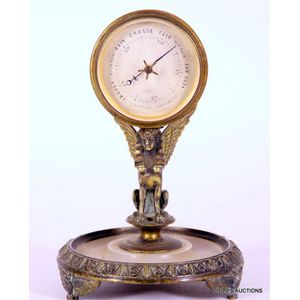Meissen Drummer Boy Mantel Clock
You must be a subscriber, and be logged in to view price and dealer details.
Subscribe Now to view actual auction price for this item
When you subscribe, you have the option of setting the currency in which to display prices to $Au, $US, $NZ or Stg.
- A/f, as Inspected - The letters "A/F" or "as inspected" as part of a description is the cataloguer's shorthand for "all faults" or "as found", meaning the item has some type of damage or deficiency, it is of uncertain date or provenance, and/or that the seller takes no responsibility for the completeness of the item or the accuracy of the description.
- Cupid Motif - The Cupid motif, which features the Roman god of love and desire, Cupid, was a popular decorative element in classical ornamentation. Cupid was often depicted as a winged, naked baby with a bow and arrow, and was often used to symbolize love and desire.
In classical art and architecture, Cupid motifs were often used as decorative elements on furniture, such as on the legs of chairs and tables, as well as on architectural elements such as friezes and pediments. They were also used as decorative elements in frescoes, mosaics, and other forms of art.
During the Renaissance, Cupid motifs were often incorporated into the decoration of palaces, churches and other grand buildings, as they were seen as symbols of love and fertility. Cupid motifs were also commonly used in the decorative arts of the Baroque period, often appearing in the form of putti, which are small winged cherub figures.
In addition to their decorative use, Cupid motifs were also believed to hold symbolic meaning, as they were thought to evoke feelings of love, desire, and fertility.
This item has been included into following indexes:
- clocks, mantle & shelf, material or style
- clocks, mantle & shelf, period or origin - Victorian 477
- Meissen (Germany) - clocks, maker or retailer 10
Visually similar items

A clock movement signed by 'John hall, Paris' mounted on a white marble Napoleonic fluted column, height 34 cm, width 14 cm, depth 14 cm

An antique bronze Egyptian revival table Barometer, the aneroid Barometer with a drum head supported on a winged sphinx above a bronze mounted alabaster base with winged creature feet, height 17 cm

Ladies enamel and gold fob watch, with circular dial, with Roman numerals with enamel surround

An English Baronet green onyx clock 18 x 10 cm
